CSM-CERES-Wheat Sensitivity to Evapotranspiration Modeling Frameworks under a Range of Wind Speeds
Abstract
1. Introduction
2. Materials and Methods
2.1. Study Area and Data Sets
2.2. Modeling Framework
2.3. Statistical Evaluation
3. Results and Discussion
3.1. The ETP Deviations
3.2. Deviations in Crop-Related Variables
4. Conclusions
Author Contributions
Funding
Institutional Review Board Statement
Informed Consent Statement
Data Availability Statement
Conflicts of Interest
References
- Brauman, K.A.; Siebert, S.; Foley, J.A. Improvements in crop water productivity increase water sustainability and food security—A global analysis. Environ. Res. Lett. 2013, 8, 024030. [Google Scholar] [CrossRef]
- Richter, B.D.; Brown, J.D.; DiBenedetto, R.; Gorsky, A.; Keenan, E.; Madray, C.; Morris, M.; Rowell, D.; Ryu, S. Opportunities for saving and reallocating agricultural water to alleviate water scarcity. Water Policy 2017, 19, 886–907. [Google Scholar] [CrossRef]
- Scott, C.A.; Vicuña, S.; Blanco-Gutiérrez, I.; Meza, F.; Varela-Ortega, C. Irrigation efficiency and water-policy implications for river basin resilience. Hydrol. Earth Syst. Sci. 2014, 18, 1339–1348. [Google Scholar] [CrossRef]
- Boote, K.J.; Jones, J.W.; Pickering, N.B. Potential Uses and Limitations of Crop Models. Agron. J. 1996, 88, 704–716. [Google Scholar] [CrossRef]
- Jones, J.W.; Antle, J.M.; Basso, B.; Boote, K.J.; Conant, R.T.; Foster, I.; Godfray, H.C.J.; Herrero, M.; Howitt, R.E.; Janssen, S.; et al. Brief history of agricultural systems modeling. Agric. Syst. 2017, 155, 240–254. [Google Scholar] [CrossRef] [PubMed]
- Jin, X.; Kumar, L.; Li, Z.; Feng, H.; Xu, X.; Yang, G.; Wang, J. A review of data assimilation of remote sensing and crop models. Eur. J. Agron. 2018, 92, 141–152. [Google Scholar] [CrossRef]
- Seidel, S.J.; Palosuo, T.; Thorburn, P.; Wallach, D. Towards improved calibration of crop models – Where are we now and where should we go? Eur. J. Agron. 2018, 94, 25–35. [Google Scholar] [CrossRef]
- Tan, J.; Cui, Y.; Luo, Y. Assessment of uncertainty and sensitivity analyses for ORYZA model under different ranges of parameter variation. Eur. J. Agron. 2017, 91, 54–62. [Google Scholar] [CrossRef]
- Wallach, D.; Makowski, D.; Jones, J.W.; Brun, F. Chapter 6—Uncertainty and Sensitivity Analysis. In Working with Dynamic Crop Models, 3rd ed.; Wallach, D., Makowski, D., Jones, J.W., Brun, F., Eds.; Academic Press: New York, NY, USA, 2019; pp. 209–250. [Google Scholar]
- Yan, L.; Jin, J.; Wu, P. Impact of parameter uncertainty and water stress parameterization on wheat growth simulations using CERES-Wheat with GLUE. Agric. Syst. 2020, 181, 102823. [Google Scholar] [CrossRef]
- Niu, X.; Easterling, W.; Hays, C.J.; Jacobs, A.; Mearns, L. Reliability and input-data induced uncertainty of the EPIC model to estimate climate change impact on sorghum yields in the U.S. Great Plains. Agr. Ecosyst. Environ. 2009, 129, 268–276. [Google Scholar] [CrossRef]
- Fodor, N.; Kovács, G.J. Sensitivity of crop models to the inaccuracy of meteorological observations. Phys. Chem. Earth Parts A B C 2005, 30, 53–57. [Google Scholar] [CrossRef]
- de Wit, A.J.W.; Boogaard, H.L.; van Diepen, C.A. Spatial resolution of precipitation and radiation: The effect on regional crop yield forecasts. Agric. For. Meteorol. 2005, 135, 156–168. [Google Scholar] [CrossRef]
- Thorp, K.R.; Marek, G.W.; DeJonge, K.C.; Evett, S.R. Comparison of evapotranspiration methods in the DSSAT Cropping System Model: II. Algorithm performance. Comput. Electron. Agric. 2020, 177, 105679. [Google Scholar] [CrossRef]
- DeJonge, K.C.; Thorp, K.R.; Marek, G.W. The apples and oranges of reference and potential evapotranspiration: Implications for agroecosystem models. Agric. Environ. Lett. 2020, 5, e20011. [Google Scholar] [CrossRef]
- Kite, G.W.; Droogers, P. Comparing evapotranspiration estimates from satellites, hydrological models and field data. J. Hydrol. 2000, 229, 3–18. [Google Scholar] [CrossRef]
- Xie, H.; Zhu, X. Reference evapotranspiration trends and their sensitivity to climatic change on the Tibetan Plateau (1970–2009). Hydrol. Processes 2013, 27, 3685–3693. [Google Scholar] [CrossRef]
- Xiang, K.; Li, Y.; Horton, R.; Feng, H. Similarity and difference of potential evapotranspiration and reference crop evapotranspiration—A review. Agric. Water Manag. 2020, 232, 106043. [Google Scholar] [CrossRef]
- Allen, R.G.; Pereira, L.S.; Raes, D.; Smith, M. Crop Evapotranspiration-Guidelines for Computing Crop Water Requirements—FAO Irrigation and Drainage Paper 56; Food and Agriculture Organization of the United Nations: Rome, Italy, 1998; p. 326. [Google Scholar]
- Corbari, C.; Ravazzani, G.; Galvagno, M.; Cremonese, E.; Mancini, M. Assessing Crop Coefficients for Natural Vegetated Areas Using Satellite Data and Eddy Covariance Stations. Sensors 2017, 17, 2664. [Google Scholar] [CrossRef]
- Thorp, K.R.; DeJonge, K.C.; Marek, G.W.; Evett, S.R. Comparison of evapotranspiration methods in the DSSAT Cropping System Model: I. Global sensitivity analysis. Comput. Electron. Agric. 2020, 177, 105658. [Google Scholar] [CrossRef]
- Sau, F.; Boote, K.J.; Bostick, W.M.; Jones, J.W.; Mínguez, M.I. Testing and Improving Evapotranspiration and Soil Water Balance of the DSSAT Crop Models. Agron. J. 2004, 96, 1243–1257. [Google Scholar] [CrossRef]
- López-Cedrón, F.X.; Boote, K.J.; Piñeiro, J.; Sau, F. Improving the CERES-Maize Model Ability to Simulate Water Deficit Impact on Maize Production and Yield Components. Agron. J. 2008, 100, 296–307. [Google Scholar] [CrossRef]
- Nouri, M.; Homaee, M. Reference crop evapotranspiration for data-sparse regions using reanalysis products. Agric. Water Manage. 2022, 262, 107319. [Google Scholar] [CrossRef]
- Garcia y Garcia, A.; Guerra, L.C.; Hoogenboom, G. Impact of generated solar radiation on simulated crop growth and yield. Ecol. Model. 2008, 210, 312–326. [Google Scholar] [CrossRef]
- Farhadi Bansouleh, B.; Sharifi, M.A.; Van Keulen, H. Sensitivity analysis of performance of crop growth simulation models to daily solar radiation estimation methods in Iran. Energy Convers. Manag. 2009, 50, 2826–2836. [Google Scholar] [CrossRef]
- Allen, R.G.; Walter, I.; Elliott, R.; Howell, T.; Itenfisu, D.; Jensen, M.; Snyder, R. The ASCE Standardized Reference Evapotranspiration Equation. 2005. Available online: https://epic.awi.de/id/eprint/42362/1/ascestzdetmain2005.pdf (accessed on 25 August 2022).
- Priestley, C.H.B.; Taylor, R.J. On the Assessment of Surface Heat Flux and Evaporation Using Large-Scale Parameters. Mon. Wea. Rev. 1972, 100, 81–92. [Google Scholar] [CrossRef]
- Hargreaves, G.; Samani, Z. Reference crop evapotranspiration from temperature. Appl. Eng. Agric. 1985, 1, 96. [Google Scholar] [CrossRef]
- Trajkovic, S. Temperature-based approaches for estimating reference evapotranspiration. J. Irrig. Drain. Eng. 2005, 131, 316–323. [Google Scholar] [CrossRef]
- Trajkovic, S.; Kolakovic, S. Estimating reference evapotranspiration using limited weather data. J. Irrig. Drain. Eng. 2009, 135, 443–449. [Google Scholar] [CrossRef]
- Todorovic, M.; Karic, B.; Pereira, L.S. Reference evapotranspiration estimate with limited weather data across a range of Mediterranean climates. J. Hydrol. 2013, 481, 166–176. [Google Scholar] [CrossRef]
- Seiller, G.; Anctil, F. How do potential evapotranspiration formulas influence hydrological projections? Hydrol. Sci. J. 2016, 61, 2249–2266. [Google Scholar] [CrossRef]
- Jensen, M.E.; Allen, R.G. Estimates of irrigation water requirements and streamflow depletion. In Evaporation, Evapotranspiration, and Irrigation Water Requirements, 2nd ed.; Jensen, M.E., Allen Richard, G., Eds.; ASCE Manuals and Reports on Engineering Practice No. 70; ASCE: New York, NY, USA, 2016; pp. 435–455. [Google Scholar]
- Anothai, J.; Soler, C.M.T.; Green, A.; Trout, T.J.; Hoogenboom, G. Evaluation of two evapotranspiration approaches simulated with the CSM–CERES–Maize model under different irrigation strategies and the impact on maize growth, development and soil moisture content for semi-arid conditions. Agric. For. Meteorol. 2013, 176, 64–76. [Google Scholar] [CrossRef]
- Cuadra, S.V.; Kimball, B.A.; Boote, K.J.; Suyker, A.E.; Pickering, N. Energy balance in the DSSAT-CSM-CROPGRO model. Agric. For. Meteorol. 2021, 297, 108241. [Google Scholar] [CrossRef]
- Blaney, H.F.; Criddle, W.D. Determining Water Requirements in Irrigated Areas from Climatological and Irrigation Data; SCS-TP 96; U.S. Department Agriculture Soil Conservation Service: Asheville, NC, USA, 1950; p. 44. [Google Scholar]
- Makkink, G.F. Testing the Penman formula by means of lysimeters. J. Inst. Water Eng. 1957, 11, 277–288. [Google Scholar]
- Huo, Z.; Dai, X.; Feng, S.; Kang, S.; Huang, G. Effect of climate change on reference evapotranspiration and aridity index in arid region of China. J. Hydrol. 2013, 492, 24–34. [Google Scholar] [CrossRef]
- Nouri, M.; Homaee, M.; Bannayan, M. Quantitative Trend, Sensitivity and Contribution Analyses of Reference Evapotranspiration in some Arid Environments under Climate Change. Water Resour. Manag. 2017, 31, 2207–2224. [Google Scholar] [CrossRef]
- Roderick, M.L.; Rotstayn, L.D.; Farquhar, G.D.; Hobbins, M.T. On the attribution of changing pan evaporation. Geophys. Res. Lett. 2007, 34, L17403. [Google Scholar] [CrossRef]
- Zhang, Y.; Liu, C.; Tang, Y.; Yang, Y. Trends in pan evaporation and reference and actual evapotranspiration across the Tibetan Plateau. J. Geophys. Res. 2007, 112, D12110. [Google Scholar] [CrossRef]
- McVicar, T.R.; Roderick, M.L.; Donohue, R.J.; Li, L.T.; Van Niel, T.G.; Thomas, A.; Grieser, J.; Jhajharia, D.; Himri, Y.; Mahowald, N.M.; et al. Global review and synthesis of trends in observed terrestrial near-surface wind speeds: Implications for evaporation. J. Hydrol. 2012, 416–417, 182–205. [Google Scholar] [CrossRef]
- Araghi, A.; Maghrebi, M.; Olesen, J.E. Effect of wind speed variation on rainfed wheat production evaluated by the CERES-Wheat model. Int. J. Biometeorol. 2021, 66, 225–233. [Google Scholar] [CrossRef]
- Chen, D.; Gao, G.; Xu, C.-Y.; Guo, J.; Ren, G. Comparison of the Thornthwaite method and pan data with the standard Penman-Monteith estimates of reference evapotranspiration in China. Clim. Res. 2005, 28, 123–132. [Google Scholar] [CrossRef]
- Nouri, M.; Homaee, M. On modeling reference crop evapotranspiration under lack of reliable data over Iran. J. Hydrol. 2018, 566, 705–718. [Google Scholar] [CrossRef]
- Razzaghi, F.; Plauborg, F.; Jacobsen, S.-E.; Jensen, C.R.; Andersen, M.N. Effect of nitrogen and water availability of three soil types on yield, radiation use efficiency and evapotranspiration in field-grown quinoa. Agric. Water Manag. 2012, 109, 20–29. [Google Scholar] [CrossRef]
- Di Paolo, E.; Rinaldi, M. Yield response of corn to irrigation and nitrogen fertilization in a Mediterranean environment. Field Crop. Res. 2008, 105, 202–210. [Google Scholar] [CrossRef]
- Doorenbos, J.; Kassam, A. Yield Response to Water; Paper 33; FAO Irrigation and Drainage Paper; FAO: Rome, Italy, 1979; p. 193. [Google Scholar]
- UNEP. World Atlas of Desertification; Arnold, Hodder Headline, PLC: London, UK, 1997; p. 182. [Google Scholar]
- Nouri, M.; Homaee, M. Drought trend, frequency and extremity across a wide range of climates over Iran. Meteorol. Appl. 2020, 27, e1899. [Google Scholar] [CrossRef]
- Nouri, M.; Homaee, M. Contribution of soil moisture variations to high temperatures over different climatic regimes. Soil Tillage Res. 2021, 213, 105115. [Google Scholar] [CrossRef]
- Bannayan, M.; Asadi, S.; Nouri, M.; Yaghoubi, F. Time trend analysis of some agroclimatic variables during the last half century over Iran. Theor. Appl. Climatol. 2020, 140, 839–857. [Google Scholar] [CrossRef]
- Saxton, K.E.; Rawls, W.J.; Romberger, J.S.; Papendick, R.I. Estimating Generalized Soil-water Characteristics from Texture. Soil Sci. Soc. Am. J. 1986, 50, 1031–1036. [Google Scholar] [CrossRef]
- Rawls, W.J.; Brakensiek, D.L.; Saxtonn, K.E. Estimation of Soil Water Properties. Trans. ASAE 1982, 25, 1316. [Google Scholar] [CrossRef]
- Nouri, M.; Homaee, M.; Bannayan, M.; Hoogenboom, G. Towards modeling soil texture-specific sensitivity of wheat yield and water balance to climatic changes. Agric. Water Manag. 2016, 177, 248–263. [Google Scholar] [CrossRef]
- Hoogenboom, G.; Porter, C.H.; Boote, K.J.; Shelia, V.; Wilkens, P.W.; Singh, U.; White, J.W.; Asseng, S.; Lizaso, J.I.; Moreno, L.P.; et al. The DSSAT crop modeling ecosystem. In Advances in Crop Modelling for a Sustainable Agriculture; Boote, K., Ed.; Burleigh Dodds Science Publishing: Cambridge, UK, 2019; pp. 173–216. [Google Scholar]
- Hoogenboom, G.; Porter, C.H.; Shelia, V.; Boote, K.J.; Singh, U.; White, J.W.; Hunt, L.A.; Ogoshi, R.; Lizaso, J.I.; Koo, J.; et al. Decision Support System for Agrotechnology Transfer (DSSAT); Version 4.7.5; DSSAT Foundation: Gainesville, FL, USA, 2019; Available online: https://DSSAT.net (accessed on 1 June 2020).
- Saseendran, S.A.; Ahuja, L.R.; Ma, L.; Timlin, D.; Stöckle, C.O.; Boote, K.J.; Hoogenboom, G. Current water deficit stress simulations in selected agricultural system models. In Response of Crops to Limited Water: Understanding and Modeling Water Stress Effects on Plant Growth Processes; Ahuja, L.R., Reddy, V.R., Saseendran, S.A., Yu, Q., Eds.; American Society of Agronomy, Inc., Crop Science Society of America, Inc., Soil Science Society of America, Inc.: Madison, WI, USA, 2008; Volume 1, pp. 1–38. [Google Scholar]
- Hanks, R.J. Model for predicting plant yield as influenced by water use. Agron. J. 1974, 66, 660–665. [Google Scholar] [CrossRef]
- de Wit, C.T. Transpiration and Crop Yields; Institute of Biological and Chemical Research on Field Crops and Herbage: Wageningen, The Netherlands, 1958; p. 88. [Google Scholar]
- Paredes, P.; Rodrigues, G.C.; Alves, I.; Pereira, L.S. Partitioning evapotranspiration, yield prediction and economic returns of maize under various irrigation management strategies. Agric. Water Manag. 2014, 135, 27–39. [Google Scholar] [CrossRef]
- Suleiman, A.A.; Ritchie, J.T. Modifications to the DSSAT vertical drainage model for more accurate soil water dynamics estimation. Soil Sci. 2004, 169, 745–757. [Google Scholar] [CrossRef]
- Ritchie, J.T.; Porter, C.H.; Judge, J.; Jones, J.W.; Suleiman, A.A. Extension of an Existing Model for Soil Water Evaporation and Redistribution under High Water Content Conditions. Soil Sci. Soc. Am. J. 2009, 73, 792–801. [Google Scholar] [CrossRef]
- Ritchie, J.T. Water dynamics in the soil-plant-atmosphere system. Plant Soil 1981, 58, 81–96. [Google Scholar] [CrossRef]
- Ritchie, J.T. Soil water balance and plant water stress. In Understanding Options for Agricultural Production. Systems Approaches for Sustainable Agricultural Development; Tsuji, G., Hoogenboom, G., Thornton, P., Eds.; Springer: Dordrecht, The Netherlands, 1998; pp. 41–54. [Google Scholar]
- Williams, J.R.; Jones, C.A.; Dyke, P.T. A modeling approach to determining the relationship between erosion and soil productivity. Trans. ASAE 1984, 27, 129–144. [Google Scholar] [CrossRef]
- Cristea, N.C.; Kampf, S.K.; Burges, S.J. Revised Coefficients for Priestley-Taylor and Makkink-Hansen Equations for Estimating Daily Reference Evapotranspiration. J. Hydrol. Eng. 2013, 18, 1289–1300. [Google Scholar] [CrossRef]
- Martínez-Cob, A.; Tejero-Juste, M. A wind-based qualitative calibration of the Hargreaves ET0 estimation equation in semiarid regions. Agric. Water Manag. 2004, 64, 251–264. [Google Scholar] [CrossRef]
- Tabari, H.; Talaee, P.H. Local Calibration of the Hargreaves and Priestley-Taylor Equations for Estimating Reference Evapotranspiration in Arid and Cold Climates of Iran Based on the Penman-Monteith Model. J. Hydrol. Eng. 2011, 16, 837–845. [Google Scholar] [CrossRef]
- Moratiel, R.; Bravo, R.; Saa, A.; Tarquis, A.M.; Almorox, J. Estimation of evapotranspiration by the Food and Agricultural Organization of the United Nations (FAO) Penman–Monteith temperature (PMT) and Hargreaves–Samani (HS) models under temporal and spatial criteria—A case study in Duero basin (Spain). Nat. Hazards Earth Syst. Sci. 2020, 20, 859–875. [Google Scholar] [CrossRef]
- Liu, J.; Williams, J.R.; Wang, X.; Yang, H. Using MODAWEC to generate daily weather data for the EPIC model. Environ. Model. 2009, 24, 655–664. [Google Scholar] [CrossRef]
- Meyer, W.S. Standard Reference Evaporation Calculation for Inland, South Eastern Australia; Laboratory Technical Report 35/98; CSIRO Land and Water: Adelaide, Australia, 1999; p. 30. [Google Scholar]
- Doorenbos, J.; Pruitt, W.O. Guidelines for Predicting Crop Water Requirements; FAO Irrigation and Drainge Papers, No. 24; Food and Agricultural Organization of the United Nations: Rome, Italy, 1977; p. 154. [Google Scholar]
- Droogers, P.; Allen, R.G. Estimating Reference Evapotranspiration Under Inaccurate Data Conditions. Irrig. Drain. Syst. 2002, 16, 33–45. [Google Scholar] [CrossRef]
- Ravazzani, G.; Corbari, C.; Morella, S.; Gianoli, P.; Mancini, M. Modified Hargreaves-Samani equation for the assessment of reference evapotranspiration in Alpine river basins. J. Irrig. Drain. Eng. 2012, 138, 592–599. [Google Scholar] [CrossRef]
- Paredes, P.; Pereira, L.S.; Almorox, J.; Darouich, H. Reference grass evapotranspiration with reduced data sets: Parameterization of the FAO Penman-Monteith temperature approach and the Hargeaves-Samani equation using local climatic variables. Agric. Water Manag. 2020, 240, 106210. [Google Scholar] [CrossRef]
- Nouri, M.; Ebrahimipak, N.A.; Hosseini, S.N. Estimating reference evapotranspiration for water-limited windy areas under data scarcity. Theor. Appl. Climatol. 2022, 150, 593–611. [Google Scholar] [CrossRef]
- Paredes, P.; Fontes, J.C.; Azevedo, E.B.; Pereira, L.S. Daily reference crop evapotranspiration with reduced data sets in the humid environments of Azores islands using estimates of actual vapor pressure, solar radiation, and wind speed. Theor. Appl. Climatol. 2017, 134, 1115–1133. [Google Scholar] [CrossRef]
- Trajkovic, S.; Gocic, M. Evaluation of three wind speed approaches in temperature-based ET0 equations: A case study in Serbia. Arab. J. Geosci. 2021, 14, 35. [Google Scholar] [CrossRef]
- Dettori, M.; Cesaraccio, C.; Motroni, A.; Spano, D.; Duce, P. Using CERES-Wheat to simulate durum wheat production and phenology in Southern Sardinia, Italy. Field Crop. Res. 2011, 120, 179–188. [Google Scholar] [CrossRef]
- Guereña, A.; Ruiz-Ramos, M.; Díaz-Ambrona, C.H.; Conde, J.R.; Mínguez, M.I. Assessment of climate change and agriculture in Spain using climate models. Agron. J. 2001, 93, 237–249. [Google Scholar] [CrossRef]
- Xiong, W.; Lin, E.; Ju, H.; Xu, Y.J.C.C. Climate change and critical thresholds in China’s food security. Clim. Change 2007, 81, 205–221. [Google Scholar] [CrossRef]
- Tao, F.; Zhang, Z. Impacts of climate change as a function of global mean temperature: Maize productivity and water use in China. Clim. Change 2011, 105, 409–432. [Google Scholar] [CrossRef]
- Wang, W.; Xing, W.; Shao, Q. How large are uncertainties in future projection of reference evapotranspiration through different approaches? J. Hydrol. 2015, 524, 696–700. [Google Scholar] [CrossRef]
- Wang, W.; Li, C.; Xing, W.; Fu, J. Projecting the potential evapotranspiration by coupling different formulations and input data reliabilities: The possible uncertainty source for climate change impacts on hydrological regime. J. Hydrol. 2017, 555, 298–313. [Google Scholar] [CrossRef]
- Randall, D.A.; Wood, R.A.; Bony, S.; Colman, R.; Fichefet, T.; Fyfe, J.; Kattsov, V.; Pitman, A.; Shukla, J.; Srinivasan, J. Climate models and their evaluation. In Climate Change 2007: The Physical Science Basis; Contribution of Working Group I to the Fourth Assessment Report of the IPCC (FAR); Solomon, S., Randall, D.A., Wood, R.A., Bony, S., Colman, R., Fichefet, T., Fyfe, J., Kattsov, V., Pitman, A., Shukla, J., et al., Eds.; Cambridge University Press: Cambridge, UK, 2007; pp. 589–662. [Google Scholar]

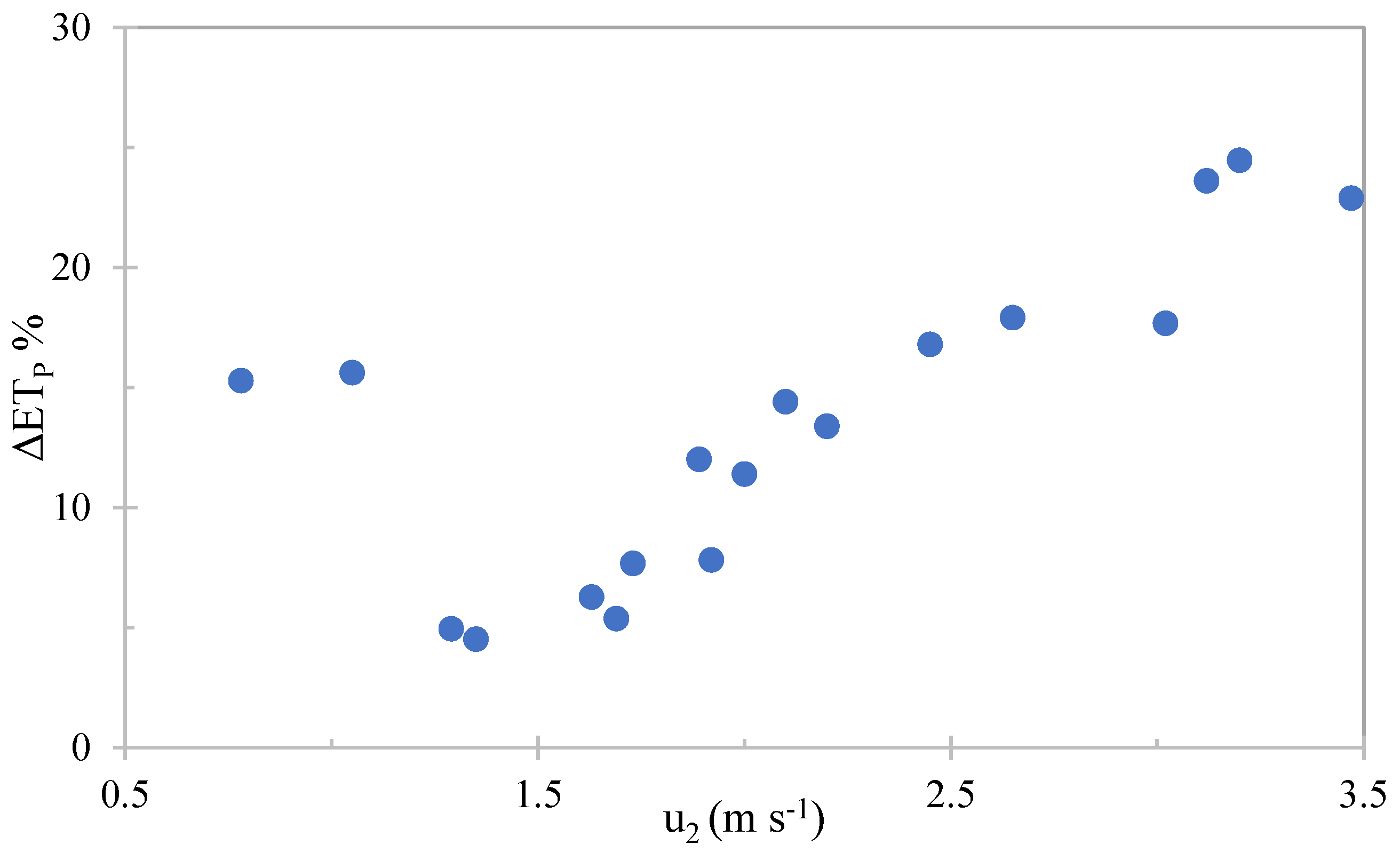
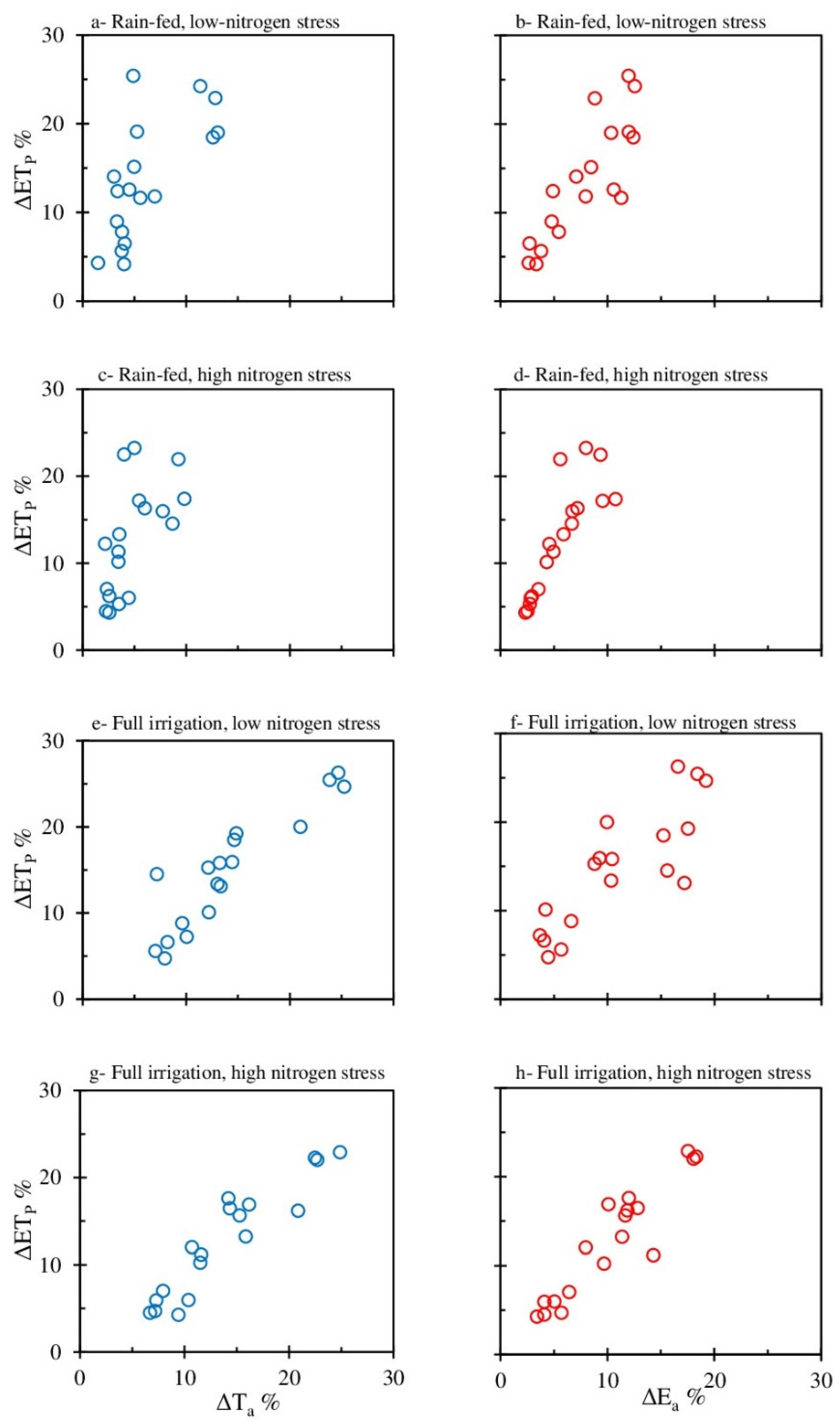
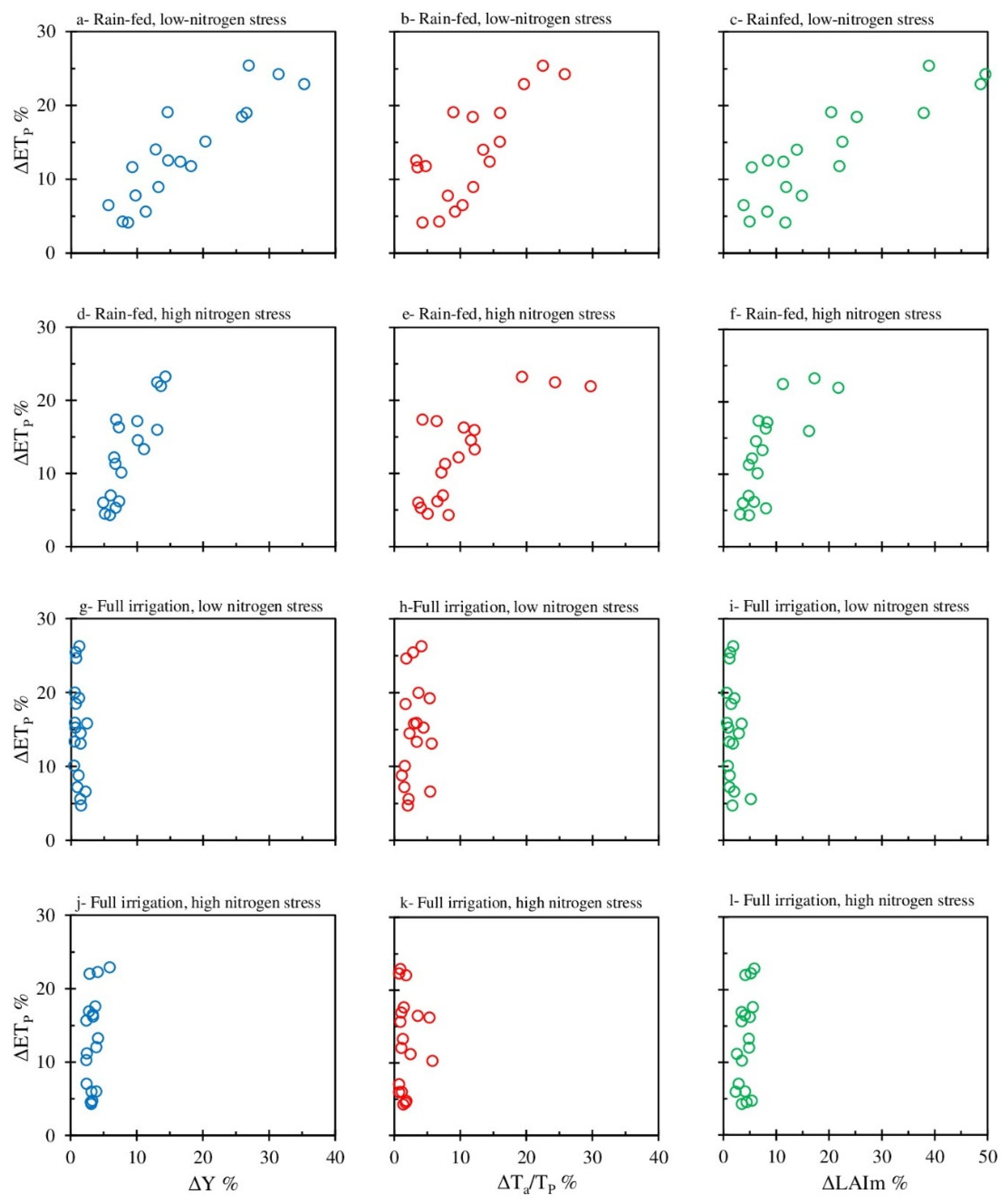
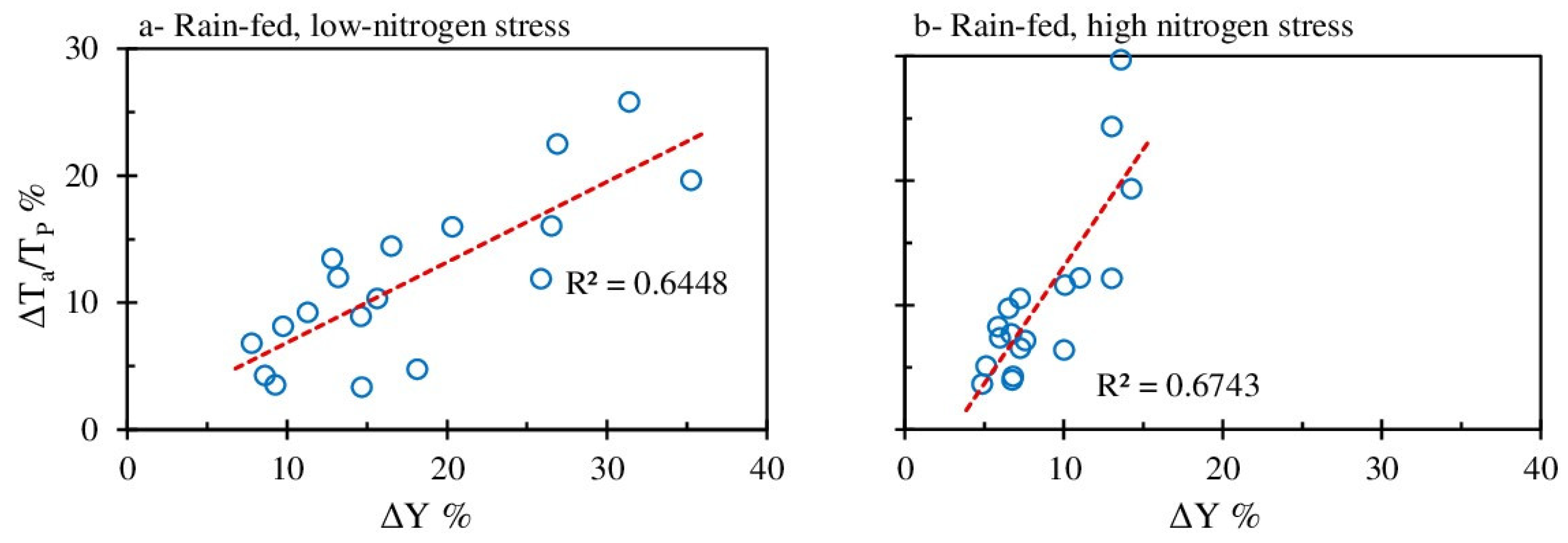
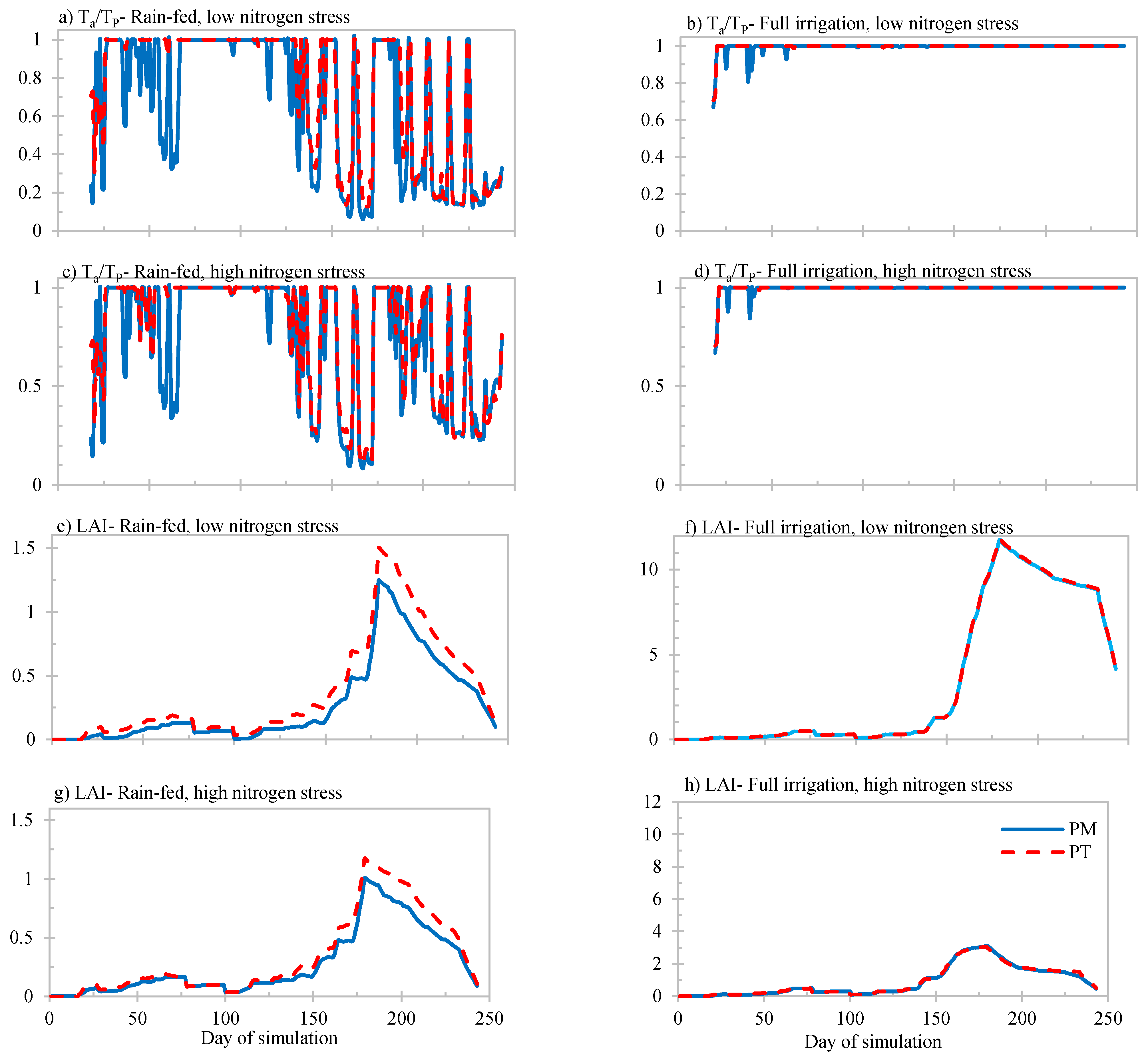
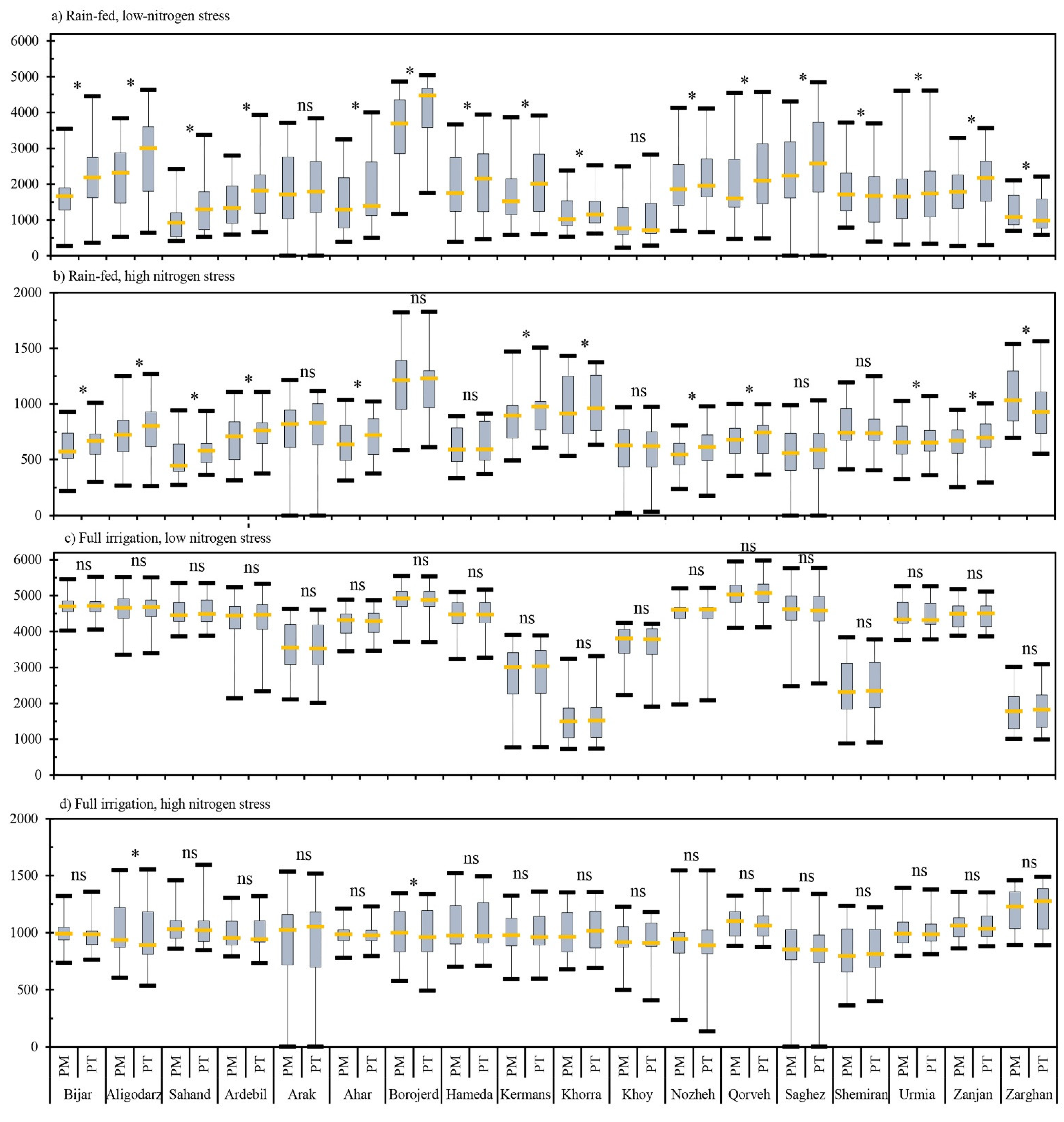
| No. | Station | Longitude | Latitude | Elevation | AI β | u2 * | P * | Tmin * | Tmax * |
|---|---|---|---|---|---|---|---|---|---|
| (°E) | (°N) | m.a.s.l α | - | m s−1 | mm | °C | |||
| 1 | Ahar | 47°04′ | 38°26′ | 1390 | 0.24 | 2.45 | 206 | 1.4 | 12.7 |
| 2 | Aligodarz | 49°42′ | 33°24′ | 2022 | 0.25 | 3.21 | 342 | 1.2 | 13.5 |
| 3 | Arak | 49°46′ | 34°06′ | 1708 | 0.21 | 1.35 | 238 | 1.7 | 13.7 |
| 4 | Ardebil | 48°17′ | 38°15′ | 1332 | 0.29 | 3.02 | 201 | 0.2 | 12.3 |
| 5 | Bijar | 47°37′ | 35°53′ | 1883 | 0.21 | 3.12 | 251 | 1.6 | 11.5 |
| 6 | Borojerd | 48°45′ | 33°55′′ | 1629 | 0.28 | 2.65 | 382 | 2.6 | 14.1 |
| 7 | Hamedan | 48°32′ | 34°52′ | 1741 | 0.23 | 1.69 | 242 | 0.2 | 13.7 |
| 8 | Kermanshah | 47°09′ | 34°21′ | 1318 | 0.26 | 1.89 | 325 | 1.8 | 15.6 |
| 9 | Khorramabad | 48°17′ | 33°26′ | 1148 | 0.29 | 1.63 | 373 | 2.9 | 16.4 |
| 10 | Khoy | 44°58′ | 38°33′ | 1103 | 0.24 | 1.29 | 205 | 1.7 | 13.2 |
| 11 | Nozheh | 48°43′ | 35°12′ | 1680 | 0.23 | 2.10 | 254 | −1.5 | 12.7 |
| 12 | Qorveh | 47°48′ | 35°10′ | 1906 | 0.23 | 2.21 | 262 | 1.4 | 12.1 |
| 13 | Saghez | 46°16′ | 36°15′ | 1523 | 0.32 | 1.92 | 318 | −1.2 | 13.0 |
| 14 | Sahand | 46°07′ | 37°56′ | 1641 | 0.20 | 3.47 | 170 | 3.2 | 11.4 |
| 15 | Shemiran | 51°29′ | 35°48′ | 1549 | 0.37 | 0.78 | 335 | 4.3 | 13.7 |
| 16 | Urmia | 45°03′ | 37°40′ | 1328 | 0.24 | 1.73 | 222 | 1.2 | 13.1 |
| 17 | Zanjan | 48°29′ | 36°41′ | 1663 | 0.22 | 2.01 | 232 | 0.7 | 13.2 |
| 18 | Zarghan | 52°43′ | 29°47′ | 1596 | 0.21 | 1.05 | 274 | 2.0 | 17.1 |
| Site | Texture Class | Sand | Silt | Clay | OC | Depth | θs * | DUL * | LL * | ρb | Ks * |
|---|---|---|---|---|---|---|---|---|---|---|---|
| % | cm | cm3 cm−3 | g·cm−3 | cm·h−1 | |||||||
| Ahar | clay loam | 28.7 | 37.2 | 34.1 | 0.64 | 125 | 0.44 | 0.35 | 0.20 | 1.30 | 0.25 |
| Aligodarz | loam | 30.8 | 44.0 | 25.2 | 0.49 | 130 | 0.42 | 0.31 | 0.15 | 1.47 | 0.52 |
| Arak | sandy clay loam | 58.2 | 16.7 | 25.1 | 0.16 | 120 | 0.39 | 0.25 | 0.15 | 1.49 | 0.85 |
| Ardebil | clay loam | 27.8 | 43.1 | 29.1 | 0.44 | 120 | 0.43 | 0.33 | 0.18 | 1.27 | 0.37 |
| Bijar | clay loam | 27.7 | 39.9 | 32.4 | 0.56 | 150 | 0.45 | 0.35 | 0.21 | 1.31 | 0.28 |
| Borojerd | loam | 44.0 | 37.4 | 18.6 | 0.41 | 150 | 0.40 | 0.26 | 0.12 | 1.44 | 1.10 |
| Hamedan | clay loam | 32.4 | 29.6 | 38.0 | 0.40 | 120 | 0.44 | 0.36 | 0.23 | 1.40 | 0.20 |
| Kermanshah | clay | 30.4 | 28.0 | 41.6 | 1.30 | 120 | 0.47 | 0.41 | 0.26 | 1.32 | 0.12 |
| Khorramabad | silty clay loam | 14.2 | 52.0 | 33.8 | 0.50 | 125 | 0.47 | 0.38 | 0.21 | 1.30 | 0.17 |
| Khoy | silt loam | 20.4 | 54.5 | 25.1 | 0.36 | 150 | 0.48 | 0.32 | 0.16 | 1.19 | 0.53 |
| Nozheh | clay loam | 25.4 | 41.1 | 33.5 | 0.23 | 100 | 0.47 | 0.34 | 0.20 | 1.29 | 0.23 |
| Qorveh | clay loam | 25.8 | 34.6 | 39.6 | 0.27 | 150 | 0.46 | 0.37 | 0.24 | 1.34 | 0.18 |
| Saghez | loam | 31.7 | 45.9 | 22.4 | 0.55 | 130 | 0.39 | 0.23 | 0.09 | 1.48 | 1.27 |
| Sahand | loam | 47.2 | 31.9 | 20.9 | 0.35 | 130 | 0.40 | 0.26 | 0.13 | 1.45 | 1.15 |
| Shemiran | clay loam | 28.8 | 40.5 | 30.7 | 0.43 | 120 | 0.44 | 0.33 | 0.19 | 1.42 | 0.32 |
| Urmia | sandy clay loam | 52.4 | 21.4 | 26.2 | 0.80 | 120 | 0.38 | 0.25 | 0.15 | 1.45 | 0.82 |
| Zanjan | sic | 10.8 | 44.5 | 44.7 | 0.38 | 150 | 0.45 | 0.42 | 0.26 | 1.36 | 0.10 |
| Zarghan | clay loam | 27.2 | 43.1 | 29.7 | 0.19 | 120 | 0.43 | 0.33 | 0.17 | 1.39 | 0.36 |
| Process and Condition | Approach |
|---|---|
| Potential evapotranspiration (ETP) | The Priestley-Taylor/Ritchie [28] and the Penman-Monteith DSSAT [19] equations |
| Potential evapotranspiration (ETP) partitioning | The method provided by Ritchie (1972) |
| Actual soil evaporation | Physically-based model using diffusion theory proposed by Suleiman and Ritchie [63] and modified by Ritchie, et al. [64] |
| Root water uptake | Single root approach described in Ritchie [65] and Ritchie [66] |
| Actual crop transpiration | Limiting transpiration flow to actual root water absorption rate [66] |
| Runoff | Modified USDA-SCS CN 1 detailed in Williams, et al. [67] |
| Weather input data | Precipitation, near-surface wind speed (u2), relative humidity, solar radiation, and minimum and maximum temperature (Tmin and Tmax) |
| Drainage | Revised vertical drainage model proposed by Suleiman and Ritchie [63] |
| Soil moisture redistribution | Modified diffusivity theory [64] |
| Lower boundary condition | Free drainage |
| Simulation start date | 30 days prior to sowing date |
| Site | Rain-Fed, Low-Nitrogen Stress | Rain-Fed, High Nitrogen Stress | Full Irrigation, Low Nitrogen Stress | Full Irrigation, High Nitrogen Stress | ETP | ||||||||
|---|---|---|---|---|---|---|---|---|---|---|---|---|---|
| Yield | Ta/TP | LAIm | Yield | Ta/TP | LAIm | Yield | Ta/TP | LAIm | Yield | Ta/TP | LAIm | ||
| Ahar | 0.25 | 0.25 | 0.35 | 0.20 | 0.35 | 0.35 | 0.10 | 0.20 | 0.10 | 0.20 | 0.25 | 0.20 | 1.00 |
| Aligodarz | 0.30 | 0.45 | 0.40 | 0.20 | 0.35 | 0.10 | 0.15 | 0.55 | 0.10 | 0.20 | 0.15 | 0.20 | 1.00 |
| Arak | 0.20 | 0.20 | 0.10 | 0.15 | 0.20 | 0.15 | 0.10 | 0.30 | 0.05 | 0.15 | 0.35 | 0.10 | 0.15 |
| Ardebil | 0.25 | 0.45 | 0.30 | 0.25 | 0.35 | 0.25 | 0.10 | 0.35 | 0.10 | 0.20 | 0.15 | 0.15 | 0.90 |
| Bijar | 0.45 | 0.50 | 0.45 | 0.30 | 0.45 | 0.30 | 0.15 | 0.45 | 0.10 | 0.20 | 0.15 | 0.15 | 1.00 |
| Borojerd | 0.35 | 0.30 | 0.30 | 0.15 | 0.35 | 0.20 | 0.10 | 0.35 | 0.10 | 0.15 | 0.35 | 0.15 | 1.00 |
| Hamedan | 0.15 | 0.25 | 0.25 | 0.15 | 0.25 | 0.10 | 0.15 | 0.20 | 0.15 | 0.15 | 0.35 | 0.20 | 0.50 |
| Kermanshah | 0.25 | 0.35 | 0.20 | 0.25 | 0.15 | 0.15 | 0.10 | 0.15 | 0.10 | 0.10 | 0.20 | 0.05 | 0.80 |
| Khorramabad | 0.15 | 0.35 | 0.15 | 0.15 | 0.25 | 0.15 | 0.10 | 0.25 | 0.05 | 0.15 | 0.15 | 0.15 | 0.50 |
| Khoy | 0.10 | 0.10 | 0.10 | 0.15 | 0.10 | 0.10 | 0.15 | 0.20 | 0.15 | 0.10 | 0.30 | 0.20 | 0.20 |
| Nozheh | 0.10 | 0.35 | 0.25 | 0.20 | 0.30 | 0.20 | 0.15 | 0.15 | 0.05 | 0.25 | 0.30 | 0.10 | 0.75 |
| Qorveh | 0.20 | 0.20 | 0.25 | 0.25 | 0.25 | 0.10 | 0.10 | 0.20 | 0.10 | 0.20 | 0.35 | 0.25 | 0.95 |
| Saghez | 0.15 | 0.25 | 0.20 | 0.15 | 0.25 | 0.10 | 0.05 | 0.20 | 0.10 | 0.10 | 0.20 | 0.10 | 0.50 |
| Sahand | 0.30 | 0.45 | 0.55 | 0.35 | 0.50 | 0.45 | 0.10 | 0.35 | 0.10 | 0.10 | 0.35 | 0.10 | 0.95 |
| Shemiran | 0.15 | 0.15 | 0.10 | 0.10 | 0.25 | 0.20 | 0.15 | 0.20 | 0.10 | 0.15 | 0.35 | 0.15 | 0.85 |
| Urmia | 0.15 | 0.20 | 0.20 | 0.15 | 0.25 | 0.10 | 0.10 | 0.25 | 0.15 | 0.10 | 0.25 | 0.05 | 0.60 |
| Zanjan | 0.25 | 0.35 | 0.30 | 0.20 | 0.20 | 0.15 | 0.10 | 0.20 | 0.10 | 0.20 | 0.15 | 0.15 | 0.70 |
| Zarghan | 0.25 | 0.15 | 0.25 | 0.25 | 0.30 | 0.25 | 0.10 | 0.15 | 0.10 | 0.10 | 0.35 | 0.15 | 0.90 |
Publisher’s Note: MDPI stays neutral with regard to jurisdictional claims in published maps and institutional affiliations. |
© 2022 by the authors. Licensee MDPI, Basel, Switzerland. This article is an open access article distributed under the terms and conditions of the Creative Commons Attribution (CC BY) license (https://creativecommons.org/licenses/by/4.0/).
Share and Cite
Nouri, M.; Hoogenboom, G.; Bannayan, M.; Homaee, M. CSM-CERES-Wheat Sensitivity to Evapotranspiration Modeling Frameworks under a Range of Wind Speeds. Water 2022, 14, 3023. https://doi.org/10.3390/w14193023
Nouri M, Hoogenboom G, Bannayan M, Homaee M. CSM-CERES-Wheat Sensitivity to Evapotranspiration Modeling Frameworks under a Range of Wind Speeds. Water. 2022; 14(19):3023. https://doi.org/10.3390/w14193023
Chicago/Turabian StyleNouri, Milad, Gerrit Hoogenboom, Mohammad Bannayan, and Mehdi Homaee. 2022. "CSM-CERES-Wheat Sensitivity to Evapotranspiration Modeling Frameworks under a Range of Wind Speeds" Water 14, no. 19: 3023. https://doi.org/10.3390/w14193023
APA StyleNouri, M., Hoogenboom, G., Bannayan, M., & Homaee, M. (2022). CSM-CERES-Wheat Sensitivity to Evapotranspiration Modeling Frameworks under a Range of Wind Speeds. Water, 14(19), 3023. https://doi.org/10.3390/w14193023






